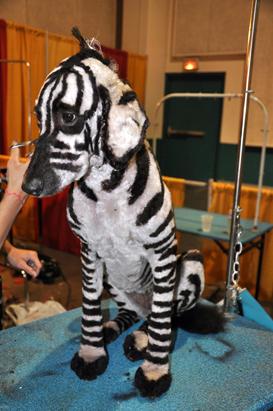By Fran Jewell
Halloween has come and gone along with the ghosts and goblins. But the fever to dress up and groom our dogs has not left so quickly. All the major pet store chains carry every imaginable dog costume around. Soon it will be Thanksgiving and Christmas costumes. How incredibly cute our dogs look all dressed up for the holidays.
Now, especially with the huge popularity of doodles [various breeds mixed with poodles] that are groomed regularly, I am seeing these dogs cut and dyed to look like other animals. Recently, on Facebook, I saw a white doodle dyed and cut to resemble a zebra. This dog truly looked like a zebra. The dog belonged to the groomer, who was in awe of their creativity, as well he should be. They are incredibly artful and creative, indeed. If you do an Internet search or YouTube search, the videos are overwhelming in number.
One poodle was being groomed and dyed as Phantom of the Opera. Another was a giraffe. One reporter on the story called it a “happiness break” for us. Indeed, it is a happiness break for we dog owners. It went on to say how safe and humane this practice was; that the dyes and blow pens groomers used were safe enough for children and that the dogs loved the hours upon hours on the grooming table. One lady said it made her want to go out and get a dog so she could have it groomed like that. Imagine getting a dog so you could groom it like a species it is not. Is this a good reason to get a dog?
This is fine and dandy for we humans (a different species) to enjoy, but let’s look at the other side. What does it do for the dog? While he may get many compliments and ogles, how do other dogs view him? I did have a client that had his doodle groomed as a lion. He called me and said his dog had started to become reactive to other dogs on walks and needed help. What I saw was a dog that did not appear to be a dog to other dogs. Other dogs were signaling to her dog either with barking, growling, stiff body language, or hard-eye stares that they were not impressed. His dog was becoming defensive and thus beginning to become reactive with return barking and lunging at the other dogs. The owner felt that he could no longer walk his dog around the neighborhood or take the dog where other dogs would be.
Unaware of how this grooming affected other dogs, he began to think his dog had the problem. In reality, who had the problem? Not the other dogs, not his dog, but the problem was his need to make his dog appear as something different from the species the dog was.
Having to undo the reactive behavior, we had to first remove the grooming so the dog looked natural again. Then it took many lessons in increased leadership and desensitization to help the dog overcome this learned behavior created by the innocent grooming.
I also witnessed another dog in a local store in a baby carriage with a baby bonnet and clothes on that was being pushed around the store. The owner was touting that the dog was a service dog so she could bring the dog into the store. Imagine this dog’s inability to communicate with other dogs simply to appease the owner’s will?
While it may appear to be fun for us, dog costumes and “fun” grooming can have devastating results for the dog as well as other dogs. It can even escalate into aggression, which becomes even more difficult to resolve. Dogs primarily communicate to other dogs with their non-verbal behaviors. Covering up or changing their natural communication skills can be devastating. We must consider this: Do costumes and grooming to satisfy our needs really help the dog?
Fran Jewell is an IAABC Certified Dog Behavior Consultant, NADOI Certified Instructor and the owner of Positive Puppy Dog Training, LLC in Sun Valley. For more information, visit positivepuppy.com or call 208-578-1565.



